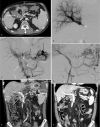Long term clinical outcomes of portal vein stenting for symptomatic portal vein stenosis after pancreaticoduodenectomy
- PMID: 34596122
- PMCID: PMC8483817
- DOI: 10.1097/MD.0000000000027264
Long term clinical outcomes of portal vein stenting for symptomatic portal vein stenosis after pancreaticoduodenectomy
Abstract
Gastrointestinal bleeding caused by portal vein (PV) stenosis is serious complication after pancreaticoduodenectomy (PD) The purpose of this study is to reveal the long-term clinical outcomes of PV stenting for symptomatic PV stenosis and risk factors of stent related complication.Fifteen patients who underwent portal vein stenting for symptomatic PV stenosis after PD between 2000 and 2018 were retrospectively reviewed. The whole cohort was divided into 9 patients with benign stenosis group (Group-B) and 6 patients with recurrence group (Group-R).The median follow up period was 17.0 (interquartile range 12.0-38.0) months. The technical success rate and clinical success rate was revealed at 93.3% and 86.7%. The primary patency rate of stents was 79.4% and mean patency period was 14.0 (4.0-28.0) months. There was significant difference in time to stenosis and proportion of anticoagulation treatment between 2 groups [2.0 (1.0-4.0) months vs 18.5 (2.5-50.3) months, P = .035 and 100% vs 50%, P = .044. In univariable analysis, stent diameter was found to have a significant correlation with stent occlusion (P = .036).PV stenting was found to be feasible and safe in the treatment of symptomatic PV stenosis from a long term point of view.
Copyright © 2021 the Author(s). Published by Wolters Kluwer Health, Inc.
Conflict of interest statement
The authors have no conflicts of interests to disclose.
Figures


References
-
- Uesaka K, Boku N, Fukutomi A, et al. . Adjuvant chemotherapy of S-1 versus gemcitabine for resected pancreatic cancer: a phase 3, open-label, randomised, non-inferiority trial (JASPAC 01). Lancet 2016;388:248–57. - PubMed
-
- Ziegler KM, Nakeeb A, Pitt HA, et al. . Pancreatic surgery: evolution at a high-volume center. Surgery 2010;148:702–9. discussion 9-10. - PubMed
-
- Kang MJ, Jang JY, Chang YR, et al. . Portal vein patency after pancreatoduodenectomy for periampullary cancer. Br J Surg 2015;102:77–84. - PubMed
-
- Kim KR, Ko GY, Sung KB, et al. . Percutaneous transhepatic stent placement in the management of portal venous stenosis after curative surgery for pancreatic and biliary neoplasms. AJR Am J Roentgenol 2011;196:W446–50. - PubMed
MeSH terms
Grants and funding
LinkOut - more resources
Full Text Sources
Medical

